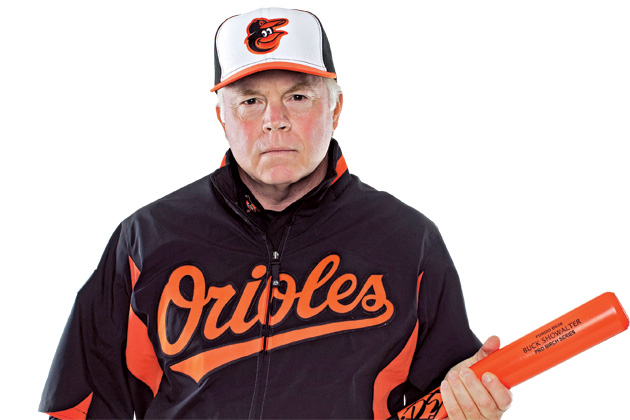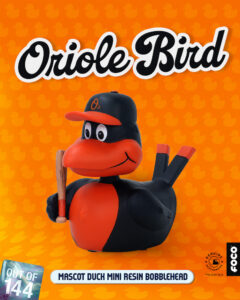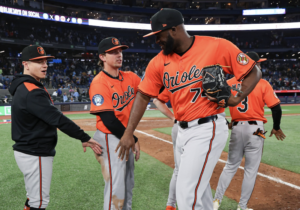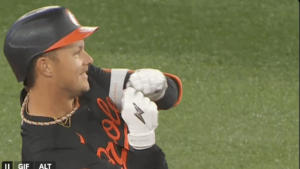In 2013 the Orioles offense was among the best in the American league at scoring runs (tied with the Cleveland Indians for the fourth most runs scored), while ranking third in doubles and being first by a wide margin in home runs, thanks in large part to Chris Davis leading all of baseball in long balls. The team also ranked third in slugging percentage and sixth in batting average, showcasing just how potent the offense was.
However, the Orioles were only tenth in on base percentage as a team because they were fourteenth in walks and were only tenth in stolen bases. That said, the offense has the ability to improve this season despite the team not retaining former left fielder Nate McClouth (who was responsible for 30 of the 79 2013 steals) or second baseman Brian Roberts. If the right lineup is used in 2014, the team can improve even further on the 2013 stats.
Consider that for the majority of the first half of last season, the team had the best offensive player – Chris Davis – batting fifth. Davis played over 100 games batting in the 5-hole. Consider also that it is estimated that each season the number 1 hitter in a lineup sees 30 more at bats than the hitter batting second, 60 more than the hitter batting third, and so on.
Therefore, I’ve made a few tweaks to the lineups from last season and have the lineup that I believe will give the team the best chance to maximize their potential in 2014:
1st Batter – Nick Markakis
This player – if healthy – should be Nick Markakis.
Markakis spent a decent amount of time in the leadoff spot last season, but also saw a lot of at bats from the 3-hole, where his below-average power cost the team chances to score more runs. Markakis does not have prototypical leadoff hitter speed like Jacoby Ellsbury or Jose Reyes, (he has only two stolen bases over the last two years) but he has a keen batter’s eye and is one of the only Orioles able to consistently draw walks. Despite a down 2013 season, Markakis still got on base at a respectable .329 clip, and has a career OBP of .360. Before last season, his career-low was .347 so he makes sense here. Markakis has also proven to be adequate at using the whole field when he hits, and has consistently hit against both lefties (.274) and righties (.270)
2nd Batter – Manny Machado
The Orioles did this correctly last year. The number two hitter in a lineup should be one of your most complete hitters, and that’s what Manny Machado was in 2013. The old school book says this should be somebody who can move over the leadoff hitter who got on base, but it actually is truer that this needs to be a hitter with a good on base percentage. Machado was among the bottom ten batters in the American league in walks, so he is not a perfect fit here but if he takes more steps forward in 2014 as he did in 2013, he can improve upon his .283 batting average and .314 on base clip. If he can turn 10 or so of his 51 doubles from last season into home runs, and continue to take strides in pitch selection he will be the best choice.
3rd Batter – Chris Davis
New sabermetrics say to not worry as much as teams have in the past about this spot; however, it is tough to argue with putting one of the best two or three hitters on the team in this spot, which makes it a prime spot to bat Chris Davis. Davis led all of baseball in home runs and RBI last season, and reached base at an impressive .370 clip.
Even if Davis loses 20% of his home runs from 2013’s breakout season, he still will be a 40 home run bat which seems sustainable based upon his 33 home runs in 2012 in fewer at bats. Davis strikes out a little more than a prototypical 3-hole batter, but his ability to get on base and hit the long ball makes him the best option. He receives the advantage over Adam Jones for this spot because putting Davis here allows the Orioles to avoid putting two right handed hitters back-to-back.
4th Batter – Adam Jones
This spot belongs to Adam Jones. Jones spent a lot of time last season batting cleanup and excelled, as he put up his fourth consecutive season with a batting average at or over .280 while setting a career high with 33 home runs. Jones doesn’t walk much, (only 25 all season) and at one point was a bit of a running joke among fans as he had an entire month without one last year. The expectation for a cleanup hitter, though, is a batter who can drive the ball, and with Jones hitting 65 home runs over the past two seasons, it seems like a perfect spot for him.
5th Batter – Nelson Cruz
This may have been the toughest spot on the team to address until the Orioles signed Nelson Cruz, because it needs to be a hitter with power, but also a hitter who can protect the cleanup guy. Cruz is a career .268 hitter and has a respectable OBP of .327, and while he has not hit over 30 home runs since 2009, he has 102 over the previous four years, and was on pace to clear that total easily before being suspended in the Biogenesis scandal last season after only 109 games.
Having consecutive right-handed batters back-to-back isn’t ideal, but Cruz is the best option for the 5th hole. The only asterisk in my opinion is that Cruz has only played in over 130 games once in his nine-year career, so in order to help him avoid injury it would not hurt to bump the next few spots up and let Henry Urrutia play when the club is facing a tough right-handed pitcher. Urrutia hit .294 against right handed pitchers in 2013 so he definitely makes sense as a platoon partner once or twice a week.
6th Batter – Matt Wieters
Matt Wieters is probably the choice by default simply because his ability to switch hit breaks up the lineup up in a lefty/righty order; however, I must note that as a left-handed hitter last year Wieters batted an abysmal .214, compared to .280 from the right side. Still, Wieters has hit over 20 home runs each of the last three seasons and has a career on base percentage of .319, an improvement from last year’s debacle of .287. On days when the team faces a left-handed starter, a case can be made for JJ Hardy here. Hardy had a superior offensive 2013 to Wieters, but the majority of the time Wieters is probably the unexciting choice.
7th Batter – J.J. Hardy
It feels crazy saying that Hardy is the seventh hitter in the lineup most days, but that is more of a testament to how deep the Orioles lineup is than a knock on Hardy. Hardy’s home run totals in three seasons since coming to Baltimore in 2011 are 30, 22, and 25, showing he can be counted on to hit for power. His batting average has fluctuated a little, as it was only .238 in 2012 but the other two seasons Hardy has hit over .260 and his career average is .260, so it appears that 2012 was the outlier. Hardy does not walk a lot, so his on base percentage will not be high, but his power makes him the safe choice for this spot.
8th Batter – David Lough/Nolan Reimold
To continue the pattern of lefty/righty this spot belongs to David Lough, who quietly made noise in the rookie of the year race in 2013 with Kansas City before coming to Baltimore in a trade for Danny Valencia this offseason.
Lough hit an impressive .286 last year, but like the rest of this team outside of Markakis and Davis, did not walk much. He drew only 10 walks in 335 plate appearances and had little power, but his speed on the base paths makes him a realistic candidate to steal 15+ bases, as he looks to replace Nate McClouth. Lough is younger than McClouth and while many fans in Baltimore have been skeptical of the replacement, it has the look of a move that fans would marvel at had it been made by a team like St. Louis or Tampa Bay to replace an older more expensive player for a younger and cheaper guy with a similar skill set.
Lough will be the primary guy here, but at times Nolan Reimold may see time if he stays healthy. Reimold was bad in 2013, but in 2012 before being injured Reimold hit over .300, and in 2009, his only full season in the big leagues, he hit .279 with an OBP of .365. These two can create a solid platoon in left field.
9th Batter – Second Baseman du jour
This will be wherever the starting second baseman hits, whether it be Ryan Flaherty, Alexi Casilla, Jemile Weeks, or Jonathan Schoop. Of these options, Schoop is the most appealing because of how unknown his ceiling can be, but the most likely option will be Flaherty most days, with Schoop beginning the season at Triple-A.
If Flaherty struggles, Schoop will likely come up later in the season, but Flaherty has a chance to be more than just an automatic out in 2014. Flaherty’s .224 batting average was not impressive last season, but his 10 home runs in only 271 plate appearances was, as was his on base percentage of .294. If Flaherty receives 400 at bats at the bottom of this lineup, there is no reason he won’t hit 15 home runs, and he seemed to find himself a little more in the second half of the year as his overall numbers were dragged down by a weak .125 batting average in April and .182 in May.
Overall Projected Lineup:
- RF Markakis
- 3B Machado
- 1B Davis
- CF Jones
- DH Cruz
- C Wieters
- SS Hardy
- LF Lough/Reimold
- Flaherty/Casilla/Weeks/Schoop
Final Word:
This lineup allows the Orioles to maximize their potential and also maintains the lefty/righty mix up that makes managers happy. The good news is, by the end of last season, this lineup is similar to the one the team used anyway, as it seems Buck Showalter seemed to understand a hitter as good as Davis needed to hit higher in the lineup and that Markakis was the team’s best leadoff threat. There may be temptation to bat David Lough lower or potentially to move him to leadoff because of his speed, but it would be the wrong move based upon his low on base percentage. That said, if Machado misses Opening Day, the best move would be to bat Hardy second, and move everybody else up one spot, assuming that utility infielder Alexi Casilla takes time at third and bats ninth. As for the platoons at left field and second base, they are the best option because there is no dynamite player at the positions already. Platoons aren’t sexy, but they work – just ask the Oakland Athletics who have ridden platoons at first base and in the outfield to consecutive AL West crowns.
So that’s my optimal O’s lineup – what’s yours?










3 Responses
I think Nick has some great points, but he really should come to me if he wants to learn a thing about baseball.
Nick made some great points. go away, fake Raymond.
Nick made some great points. Can the real raymond zink please stand up?